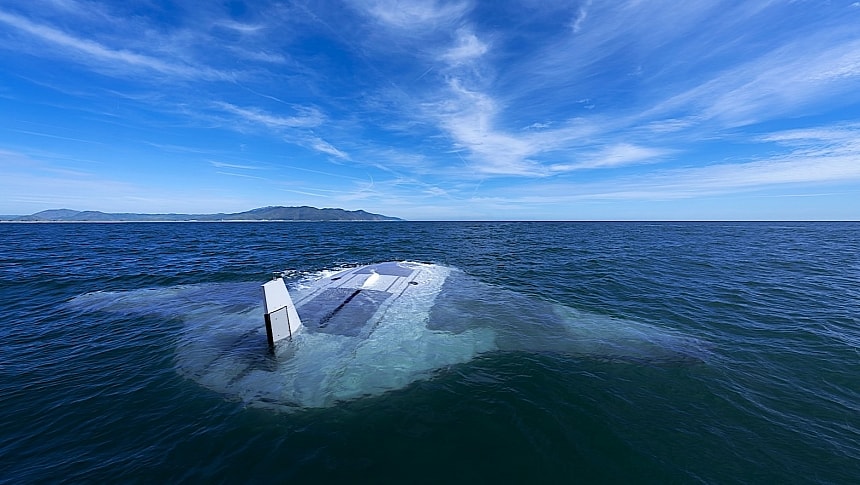At the beginning of April the world got news of the first example of a brand-new breed of uncrewed underwater vehicles (UUV) being ready. The company that broke the news was Northrop Grumman, and it appears these guys only let us know about the drone after the completion of some crucial testing under the guidance of the Defense Advanced Research Projects Agency (DARPA).
The vehicle is called Manta Ray, and it is the result of a program DARPA initiated about four years ago. The goal of the research is to come up with multi-use underwater vehicles that could be used for "long-duration, long-range missions in ocean environments."
Two projects have been selected by DARPA to move forward, one run by Northrop Grumman and the other by PacMar Technologies. It seems like the product of the former, the one that was shown publicly at the beginning of last month, had already completed full-scale, in-water testing in February and March, something we only recently learned about.
The Northrop Grumman design is built in such a way it kind of looks like something that'll give even the most fearsome creatures of the ocean nightmares. Streamlined for underwater use and in some respect mimicking the looks of a real manta ray, the drone also looks quite large – just look at the photos in the attached gallery to see two people sitting on it with plenty of room to spare.
The exact specs of the drone were not disclosed, but as per DARPA's requirements, it's supposed to be powered by new technologies, including the kind that will give the drone the ability to harvest energy from underwater sources. The materials it is made from should protect it from the dangers of the deep, including biofouling and corrosion.
Northrop Grumman's design was put through its paces off the coast of Southern California, with DARPA's people looking at how the machine behaves hydrodynamically, how its buoyancy is, how the propellers work, and what the control surfaces are doing.
The underwater ship was designed to have a number of payload bays of various sizes, but we're not informed on whether they were loaded during the test runs.
As per the details made public by DARPA it was not only the drone itself that was tested, but also the logistics of fielding it. We learned the vehicle was shipped from Maryland to Cali not assembled, but in subsections that were put together on location.
This, it seems, is a crucial aspect America is looking for, especially because it envisions the system to be ready for fast deployment anywhere in the world.
The completion of the tests marks the "vehicle’s readiness to advance toward real-world operations," but we are not informed as to when we are to expect that. The drone will primarily be used for military purposes, and the U.S. Navy is already involved in preparing the next tests for the system.
As for what the other company, Pacmar, is working on, the last time we heard about its Manta Ray was back in October 2023, when the drone's sensors, hydrodynamics, and autonomy were put through their paces. Presently, DARPA says Pacmar will be “continuing testing its full-scale energy harvesting system in 2024."
Two projects have been selected by DARPA to move forward, one run by Northrop Grumman and the other by PacMar Technologies. It seems like the product of the former, the one that was shown publicly at the beginning of last month, had already completed full-scale, in-water testing in February and March, something we only recently learned about.
The Northrop Grumman design is built in such a way it kind of looks like something that'll give even the most fearsome creatures of the ocean nightmares. Streamlined for underwater use and in some respect mimicking the looks of a real manta ray, the drone also looks quite large – just look at the photos in the attached gallery to see two people sitting on it with plenty of room to spare.
The exact specs of the drone were not disclosed, but as per DARPA's requirements, it's supposed to be powered by new technologies, including the kind that will give the drone the ability to harvest energy from underwater sources. The materials it is made from should protect it from the dangers of the deep, including biofouling and corrosion.
Northrop Grumman's design was put through its paces off the coast of Southern California, with DARPA's people looking at how the machine behaves hydrodynamically, how its buoyancy is, how the propellers work, and what the control surfaces are doing.
The underwater ship was designed to have a number of payload bays of various sizes, but we're not informed on whether they were loaded during the test runs.
As per the details made public by DARPA it was not only the drone itself that was tested, but also the logistics of fielding it. We learned the vehicle was shipped from Maryland to Cali not assembled, but in subsections that were put together on location.
This, it seems, is a crucial aspect America is looking for, especially because it envisions the system to be ready for fast deployment anywhere in the world.
The completion of the tests marks the "vehicle’s readiness to advance toward real-world operations," but we are not informed as to when we are to expect that. The drone will primarily be used for military purposes, and the U.S. Navy is already involved in preparing the next tests for the system.
As for what the other company, Pacmar, is working on, the last time we heard about its Manta Ray was back in October 2023, when the drone's sensors, hydrodynamics, and autonomy were put through their paces. Presently, DARPA says Pacmar will be “continuing testing its full-scale energy harvesting system in 2024."









